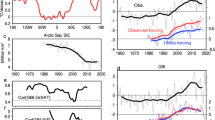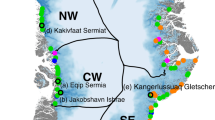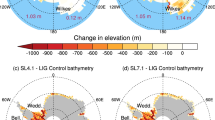Abstract
It is thought1,2 that the Northern Hemisphere experienced only ephemeral glaciations from the Late Eocene to the Early Pliocene epochs (about 38 to 4 million years ago), and that the onset of extensive glaciations did not occur until about 3 million years ago3,4. Several hypotheses have been proposed to explain this increase in Northern Hemisphere glaciation during the Late Pliocene5,6,7,8,9,10,11. Here we use a fully coupled atmosphere–ocean general circulation model and an ice-sheet model to assess the impact of the proposed driving mechanisms for glaciation and the influence of orbital variations on the development of the Greenland ice sheet in particular. We find that Greenland glaciation is mainly controlled by a decrease in atmospheric carbon dioxide during the Late Pliocene. By contrast, our model results suggest that climatic shifts associated with the tectonically driven closure of the Panama seaway5,6, with the termination of a permanent El Niño state7,8,9 or with tectonic uplift10 are not large enough to contribute significantly to the growth of the Greenland ice sheet; moreover, we find that none of these processes acted as a priming mechanism for glacial inception triggered by variations in the Earth’s orbit.
This is a preview of subscription content, access via your institution
Access options
Subscribe to this journal
Receive 51 print issues and online access
$199.00 per year
only $3.90 per issue
Buy this article
- Purchase on Springer Link
- Instant access to full article PDF
Prices may be subject to local taxes which are calculated during checkout


Similar content being viewed by others
References
Eldrett, J., Harding, I. C., Wilson, P. A., Butler, E. & Roberts, A. P. Continental ice in Greenland during the Eocene and Oligocene. Nature 446, 176–179 (2007)
Thiede, J. et al. Late Cenozoic history of the polar North Atlantic: Results from ocean drilling. Quat. Sci. Rev. 17, 185–208 (1998)
Maslin, M. A., Li, X. S., Loutre, M.-F. & Berger, A. The contribution of orbital forcing to the progressive intensification of Northern Hemisphere glaciation. Quat. Sci. Rev. 17, 411–426 (1998)
Bartoli, G. et al. Final closure of Panama and the onset of northern hemisphere glaciation. Earth Planet. Sci. Lett. 237, 33–44 (2005)
Keigwin, L. D. Isotopic paleoceanography of the Caribbean and East Pacific: Role of Panama uplift in Late Neogene time. Science 217, 350–353 (1982)
Haug, G. H. & Tiedemann, R. Effect of the formation of the Isthmus of Panama on Atlantic Ocean thermohaline circulation. Nature 393, 673–676 (1998)
Wara, M. W., Ravelo, A. C. & Delaney, M. L. Permanent El Niño-like conditions during the Pliocene warm period. Science 309, 758–761 (2005)
Haywood, A. M., Dekens, P., Ravelo, A. C. & Williams, M. Warmer tropics during the mid-Pliocene? Evidence from alkenone paleothermometry and a fully coupled ocean–atmosphere GCM. Geochem. Geophys. Geosyst. 6 10.1029/2004GC000799 (2005)
Philander, S. G. & Fedorov, A. V. Role of tropics in changing the response to Milankovich forcing some three million years ago. Paleoceanography 18 10.1029/2002PA000837 (2003)
Ruddiman, W. F. & Kutzbach, J. E. Forcing of Late Cenozoic Northern Hemisphere climate by plateau uplift in southern Asia and the American West. J. Geophys. Res. 94, 18409–18427 (1989)
Raymo, M. E. & Ruddiman, W. F. Tectonic forcing of late Cenozoic climate. Nature 359, 117–122 (1992)
Greenwood, D. R. & Wing, S. L. Eocene continental climates and latitudinal temperature gradients. Geology 23, 1044–1048 (1995)
Edgar, K. M., Wilson, P. A., Sexton, P. F. & Suganuma, Y. No extreme bipolar glaciation during the main Eocene calcite compensation shift. Nature 448, 908–911 (2007)
Siegenthaler, U. et al. Stable carbon cycle-climate relationship during the Late Pleistocene. Science 310, 1313–1317 (2005)
Pagani, M., Zachos, J. C., Freeman, K. H., Tipple, B. & Bohaty, S. Marked decline in atmospheric carbon dioxide concentrations during the Paleogene. Science 309, 600–603 (2005)
Pearson, P. N. & Palmer, M. R. Atmospheric carbon dioxide concentrations over the past 60 million years. . Nature 406, 695–699 (2000)
Pagani, M., Freeman, K. H. & Arthur, M. A. Late Miocene atmospheric CO2 concentrations and the expansion of C4 grasses. Science 285, 876–879 (1999)
Raymo, M. E., Grant, B., Horowitz, M. & Rau, G. H. Mid-Pliocene warmth: stronger greenhouse and stronger conveyor. Mar. Micropaleontol. 27, 313–326 (1996)
Kürschner, W. M., van der Burgh, J., Visscher, H. & Dilcher, D. L. Oak leaves as biosensors of late Neogene and early Pleiostocene paleoatmospheric CO2 concentrations. Mar. Micropaleontol. 27, 299–312 (1996)
Lunt, D. J., Valdes, P. J., Haywood, A. & Rutt, I. C. Closure of the Panama Seaway during the Pliocene: implications for climate and Northern Hemisphere glaciation. Clim. Dyn. 30, 1–18 (2008)
Soloman, S. et al. Climate Change 2007: The Physical Science Basis (Contribution of Working Group I to the Fourth, Assessment Report of the IPCC, Cambridge Univ. Press, 2007)
Lisiecki, L. E. & Raymo, M. E. A Pliocene-Pleistocene stack of 57 globally distributed benthic δ18O records. Paleoceanography 20 10.1029/2004PA001071 (2005)
Gordon, C. et al. The simulation of SST, sea ice extents and ocean heat transports in a version of the Hadley Centre coupled model without flux adjustments. Clim. Dyn. 16, 147–168 (2000)
Payne, A. J. A thermomehanical model of ice flow in West Antarctica. Clim. Dyn. 15, 115–125 (1999)
Haywood, A. M. & Valdes, P. J. Modelling Middle Pliocene warmth: contribution of atmosphere, oceans and cryosphere. Earth Planet. Sci. Lett. 218, 363–377 (2004)
Haywood, A. M., Valdes, P. J. & Peck, V. L. A permanent El Niño-like state during the Pliocene? Paleoceanography 22 10.1029/2006PA001323 (2007)
Hill, D. J., Haywood, A. M., Hindmarsh, R. C. A. & Valdes, P. J. in Deep Time Perspectives on Climate Change: Marrying the Signal from Computer Models and Biological Proxies (eds Williams, M., Haywood, A. M., Gregory, F. J. & Schmidt, D. N.) Micropalaeontol. Soc. Spec. Publ. 2, 517–538 (Geol. Soc. London, 2007)
Schmidt, D. N. in Deep Time Perspectives on Climate Change: Marrying the Signal from Computer Models and Biological Proxies (eds Williams, M., Haywood, A. M., Gregory, F. J. & Schmidt, D. N.) Micropalaeontol. Soc. Spec. Publ. 2, 427–442 (Geol. Soc. London, 2007)
Japsen, P. & Chalmers, J. A. Neogene uplift and tectonics around the North Atlantic: overview. Global Planet. Change 24, 165–173 (2000)
Berger, A. & Loutre, M.-F. Insolation values for the climate of the last 10 million years. Quat. Sci. Rev. 10, 297–317 (1991)
Acknowledgements
This work was carried out in the framework of the British Antarctic Survey GEACEP (Greenhouse to ice-house: Evolution of the Antarctic Cryosphere and Palaeoenvironment) programme. D.J.L. is funded by BAS and RCUK fellowships. G.L.F. is funded by a NERC research fellowship. E.J.S. is funded by a NERC studentship.
Author Contributions D.J.L. carried out the GCM and ice-sheet model simulations, except for the permanent El Niño GCM simulation, which was provided by P. Valdes at the University of Bristol, UK. A.M.H. contributed to setting up the Pliocene control and permanent El Niño GCM simulations. D.J.L., G.L.F. and A.M.H. were involved in the study design. E.J.S. devised parts of the ice-sheet model driver and experimental set-up. All authors discussed the results and commented on the manuscript.
Author information
Authors and Affiliations
Corresponding author
Supplementary information
Supplementary Information
The file contains Supplementary Notes with additional references, :Supplementary Figures 1-9 with Legends and Supplementary Tables 1-3. (PDF 8954 kb)
PowerPoint slides
Rights and permissions
About this article
Cite this article
Lunt, D., Foster, G., Haywood, A. et al. Late Pliocene Greenland glaciation controlled by a decline in atmospheric CO2 levels. Nature 454, 1102–1105 (2008). https://doi.org/10.1038/nature07223
Received:
Accepted:
Issue Date:
DOI: https://doi.org/10.1038/nature07223
This article is cited by
-
Rapid strengthening of westerlies accompanied intensification of Northern Hemisphere glaciation
Nature Communications (2023)
-
Systematics and evolutionary history of the genus Micromys (Mammalia: Rodentia: Muridae)
Mammalian Biology (2023)
-
Opening of the Fram Strait led to the establishment of a modern-like three-layer stratification in the Arctic Ocean during the Miocene
arktos (2021)
-
Facies architecture and spatio-temporal depositional variability in the Pliocene Sandhan fluvial system, Kutch Basin, India
Journal of Earth System Science (2021)
-
Late Pliocene to early Pleistocene climate dynamics in western North America based on a new pollen record from paleo-Lake Idaho
Palaeobiodiversity and Palaeoenvironments (2021)
Comments
By submitting a comment you agree to abide by our Terms and Community Guidelines. If you find something abusive or that does not comply with our terms or guidelines please flag it as inappropriate.



